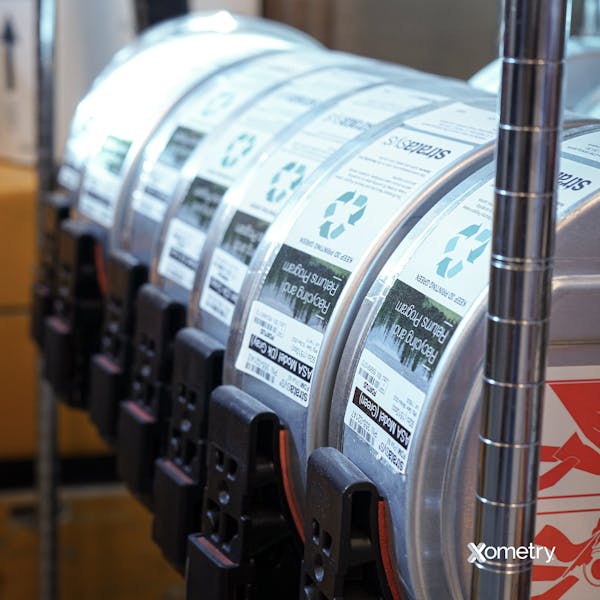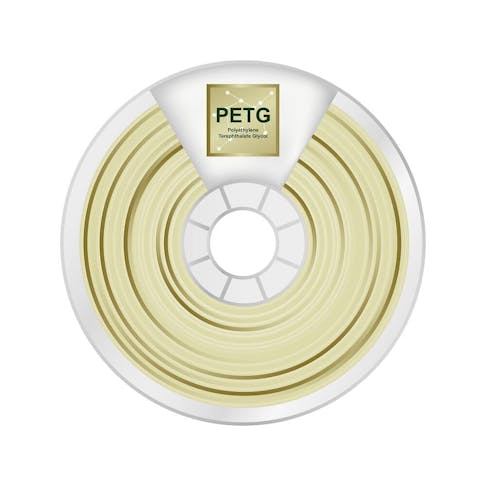Companies have no shortage of 3D printing types to choose from. A popular option that pops up on many manufacturers’ radars is 3D printing with polyethylene terephthalate glycol, more easily known as PETG. It’s often looked at as a method that offers a blend of the benefits found in ABS and PLA printing separately.
It’s commonly used in fused deposition modeling printing and is heralded for its food-safe characteristics. It’s helpful for many uses, but it can be tricky to extrude, so it’s worth learning about every facet of PETG.
What Is PETG 3D Printing?
This style of 3D printing uses PETG filament, which has a modified glycol molecule. It’s viewed as especially useful by print enthusiasts and professionals because it’s less likely to warp, it has high impact strength and low haze, and it’s pretty low cost compared to other types.
You can scroll through our 3D printing guide to get a better idea of whether PETG is the best method for your application or if there’s a better type of printer and filament out there. You can also see how PETG filaments look in a roll-up filament format in the picture below.

What Is the Composition of PETG Filament?
The composition of PETG is derived from the composition of polyethylene terephthalate (PET). They are similar in their chemical composition except for the fact that PETG has been enhanced by modifying its glycol content. PETG is formed by replacing ethylene glycol in PET with cyclohexanedimethanol (CHDM). This is what the “G” in PETG indicates. It is clearer, less brittle, and prints more easily compared to PET.
What Are the Properties of PETG Filament?
A PETG filament has certain properties that make it distinguishable from other filament materials, namely:
- High chemical and impact resistance.
- Good thermal stability.
- It is a food-safe material.
- Its extrusion temperature falls in the range of 220-260 °C.
- It can be printed at a rate of about 40-60 mm/s.
- The print bed must be heated to about 80 °C. Anything above this will lead to the warping of the print.
Comparison of PETG Filament Properties
If you’re wondering how PETG compares to other popular filaments, we’ve broken down some of the major differences in the table below.
| Property | PETG | ABS | TPU | PLA |
|---|---|---|---|---|
Property Fumes | PETG Non-toxic (but you still need proper ventilation) | ABS Toxic | TPU Non-toxic (but you still need proper ventilation) | PLA Non-toxic (but you still need proper ventilation) |
Property Hygroscopic | PETG Yes | ABS Yes | TPU Yes | PLA Yes |
Property Heated bed temperature | PETG 70–90 °C | ABS 80–110 °C | TPU 60–90 °C | PLA 20–60 °C |
Property Melting/extruder temperature | PETG 220–260 °C | ABS 210–250 °C | TPU 190–245 °C | PLA 180–230 °C |
Property Biodegradable | PETG No | ABS No | TPU No | PLA Yes, but it takes a long time — around 80 years |
Property Strength/impact resistance | PETG Very good, but it’s prone to scratches | ABS Good | TPU Very Good | PLA Average |
Property Recyclable | PETG Yes | ABS Yes | TPU Yes | PLA Yes |
PETG Filament vs. Other Filaments
What Are the Limitations of 3D Printing with PETG?
PETG has a number of advantages that makes it good for 3D printing, including its high impact resistance, odorless fumes, and good thermal stability. There are still some disadvantages associated with PETG compared to ABS, however. PETG cannot be easily stored because of its high hygroscopicity. Another limitation of PETG is that it is difficult, if not impossible, to paint. ABS, on the other hand, is far more forgiving in this area: in fact, post-processing of ABS is relatively easy.
Why Is PETG Used in 3D Printing?
PETG is a highly beneficial thermoplastic printing material because it is versatile and easy to print. Due to its versatility, it is used by many 3D printing companies and private individuals alike for their printed models or parts. PETG is appreciated by many for its: hygroscopic, ease of printability, and smooth surface finish.
How To Use PETG in 3D Printing
Just like PLA, PETG is known for its ease of printability. If PETG filament is printed according to the manufacturer's and printer's recommendations, the resulting prints should meet the customer’s requirements. Here are some tips and tricks for 3D printing with PETG:
- The temperature of the heated bed should be around 80-90 °C.
- The melting or extrusion temperature should be anywhere from 220-260 °C.
- The hot end (the device responsible for melting the thermoplastic) does not have to be fully metallic. Hot ends with PTFE inner tubes can also be used.
- Part quality can be improved by using layer fans. A layer fan is a small fan placed at the 3D printer head that cools the plastic once it is deposited.
- To achieve good layer adhesion when printing with PETG, glass surfaces and adhesives such as hairspray should be used. If the PETG print is placed directly on glass, it is most likely going to stick too firmly to the glass surface – making it difficult to separate. Using adhesives ensures good adhesion while facilitating the easy separation of the print from the build surface.
What Are the Best Configuration Settings for PETG 3D Printing?
If you are printing with a PETG filament, these are the usual configurations that should work best for your printer. Of course, it’s always best to check the user manual for your specific printer:
| Printer Setting | Configuration |
|---|---|
Printer Setting Extruder temperature | Configuration 220–260 °C |
Printer Setting Bed temperature | Configuration 70–90 °C |
Printer Setting Print speed | Configuration 40–60 mm/s |
Printer Setting Retraction speed | Configuration 35–40 mm/s |
Printer Setting Retraction distance (direct drive extruders) | Configuration 2–4 mm |
Printer Setting Retraction distance (Bowden extruders) | Configuration 5–7 mm |
Printer Setting Flow rate of filament | Configuration 95–100% |
Printer Setting Layer height | Configuration 0.28 mm |
Printer Setting Bed material | Configuration Polyetherimide (PEI) surface |
PETG Filament 3D Printer Settings
Tips for Printing with PETG
To keep warping at bay and create the most impeccable prints possible, we’ve come up with a few helpful pointers:
- Keep the bed temperature within the right range for PETG (70–90 °C) as well as the extruder temperature (220–260 °C).
- Use the right hot end for your printer — for PETG, metal and PTFE inner tubes are both fine.
- Bring in a layer fan to help cool the layers of plastic faster, as this can also boost the quality.
- A glass print bed is great, but PETG is known to stick. Using something as commonplace as hairspray can help keep your bed safe and will help you remove the print more easily.
Frequently Asked Questions About PETG 3D Printing Filament
What are the benefits of PETG printing?
Users like that PETG prints can be high quality and have better consistency, which can often be put down to the slower print rate. Its fumes aren’t toxic, especially in comparison to ABS, and it’s also a relatively strong thermoplastic. Its cheaper cost also makes it an attractive option.
What are the disadvantages of PETG printing?
There are a few things that might turn users off from using PETG. One downfall is that it’s extremely hygroscopic, which makes it hard to store. It’s also known for sticking to print beds, which causes some annoyance and can hurt the print integrity. PETG is also much harder to paint and post-process.
Is PETG easier to print with than PLA?
Users find that it’s more difficult to print with PLA in comparison to PETG. This is because PETG requires a hotter bed and extruder temperature. However, PETG does have a higher strength than its PLA counterpart.
What Is the Best PETG 3D Print Speed?
The best printing speed for PETG is between 40 and 60 mm/s. Anything faster than this may negatively impact the quality of the print. However, if the 3D printer is well-tuned and stable, the model may be printed faster without reducing the quality of the print very much. If the hot end efficiently melts the filament, it is okay to print at a higher speed. One factor to consider when printing is to ensure that the first layer of the print or model is printed at a lower speed. Printing slower will give enough time for the filament material to melt and helps in the adhesion to subsequent layers.
What Is the Melting Temperature of PETG Filament?
The melting temperature for PETG is anywhere between 220-260 °C. Different brands of filaments may show slight differences in the temperature range. Consult the manufacturer's product specifications for the expected melting temperature of your PETG filament.
Is a Heated Printing Bed Required When Printing With PETG?
No, a heated printing bed is not necessary. The reason is that PETG does not experience as much warping as thermoplastic materials such as ABS. Using a printing bed, however, is not a bad idea since it reduces the chances of filament warping.
Is PETG Biodegradable?
No, PETG is not biodegradable. PETG is an oil-based thermoplastic material and is non-biodegradable.
Is PETG Recyclable?
Yes, PETG is recyclable. It is one of the easiest thermoplastics to recycle. Many recycling programs accept this product and serve as evidence that it is eco-friendly.
Is PETG Hygroscopic?
Yes, PETG is hygroscopic. It has a strong affinity for moisture in the air. This property alone can have a negative impact on print quality. Exposing the filament to a humid environment will cause it to deteriorate faster. Storing PETG properly and using a filament dry box/ spool holder when printing helps avoid the filament from absorbing moisture.
What Is the Difference Between PETG and PLA in 3D Printing?
PETG is created from a thermoplastic material called PET. The G in PETG indicates that the glycol content in PET has been modified. PETG is 100% recyclable, though not biodegradable. PLA, on the other hand, is made from plant-based or natural materials such as corn. It is therefore both biodegradable (over time - about 80 years) AND recyclable. PETG is tougher and has better chemical and water resistance than PLA.
What Is the Difference Between PETG and PLA+ in 3D Printing?
PLA+ also called PLA Pro, Pro PLA (or PHA) is a superior version of PLA but the additives which were added to PLA to create PLA+ are unknown. Many manufacturers have refused to disclose information relating to this though some people speculate TPU - another thermoplastic filament - was used. Despite this improvement, PLA+ still comes behind PETG. PETG produces higher-strength parts than PLA+. However, PLA+ is biodegradable, making it a more eco-friendly product.
What Is the Difference Between PETG and PET in 3D Printing?
PET was created by combining two monomers. PETG still involves the same monomers though fundamentally it was created by modifying the glycol content of PET. PETG is better suited to higher temperatures and has better shock resistance than PET.
How Xometry Can Help
We are big backers of 3D printing here at Xometry and provide numerous services under this umbrella, from plastic 3D printing to selective laser sintering to polyjet. Check out our website for more options and get a free quote.
Disclaimer
The content appearing on this webpage is for informational purposes only. Xometry makes no representation or warranty of any kind, be it expressed or implied, as to the accuracy, completeness, or validity of the information. Any performance parameters, geometric tolerances, specific design features, quality and types of materials, or processes should not be inferred to represent what will be delivered by third-party suppliers or manufacturers through Xometry’s network. Buyers seeking quotes for parts are responsible for defining the specific requirements for those parts. Please refer to our terms and conditions for more information.


